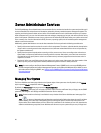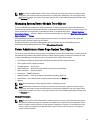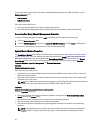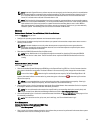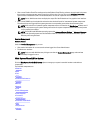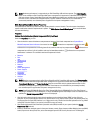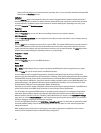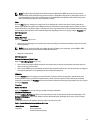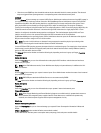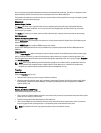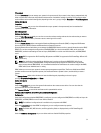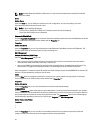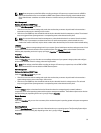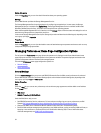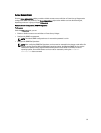
Unknown Reason
Normal [N/A]
• Properties
• Subtab: Information
Under the Properties tab, you can view the details of system’s performance degradation.
Intrusion
Click the Intrusion object to manage your system's chassis intrusion status. Server Administrator monitors chassis
intrusion status as a security measure to prevent unauthorized access to your system's critical components. Chassis
intrusion indicates that someone is opening or has opened the cover of the system's chassis. The Intrusion object action
window can have the following tabs, depending on the user's group privileges: Properties and Alert Management
Properties
Subtab: Intrusion
Under the Properties tab, you can view the chassis intrusion status.
Alert Management
Subtabs: Alert Actions | SNMP Traps
Under the Alert Management tab, you can:
• View the current alert actions settings and set the alert actions that you want to be performed in the event that the
intrusion sensor returns a warning or failure value.
• View the current SNMP trap alert thresholds and set the alert threshold levels for the intrusion sensor. The selected
traps are triggered if the system generates a corresponding event at the selected severity level.
Memory
Click the Memory object to manage your system's memory devices. Server Administrator monitors the memory device
status for each memory module present in the monitored system. Memory device prefailure sensors monitor memory
modules by counting the number of ECC memory corrections. Server Administrator also monitors memory redundancy
information if your system supports this feature. The Memory object action window can have the following tabs,
depending on the user's group privileges: Properties and Alert Management.
Properties
Subtab: Memory
Under the Properties tab, you can view the memory redundancy status, memory array attributes, total capacity of the
memory arrays, details of memory arrays, memory device details, and memory device status. The memory device details
provides the details of a memory device on a connector such as the status, device name, size, type, speed, rank, and
failures. A rank is a row of dynamic random access memory (DRAM) devices comprising 64 bits of data per Dual Inline
Memory Module (DIMM). The possible values of rank are single, dual, quad, octal, and hexa. The rank
displays the rank of the DIMM and helps in the easy service of DIMMs on the server.
NOTE: If a system with spare bank memory enabled enters a redundancy lost state, it may not be apparent which
memory module is the cause. If you cannot determine which DIMM to replace, see the
switch
to spare memory
bank detected log entry in the ESM system log to find which memory module failed.
Alert Management
Subtabs: Alert Actions | SNMP Traps
Under the Alert Management tab, you can:
• View the current alert actions settings and set the alert actions that you want to be performed in the event that a
memory module returns a warning or failure value.
48



